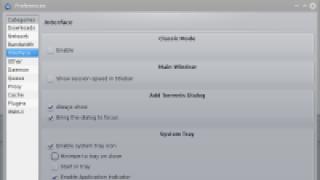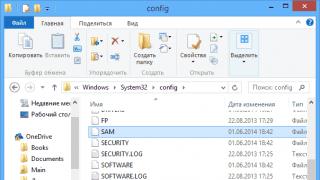In many articles on the site, I told you how to perform this or that action using the Windows Registry Editor - disable autorun of disks, remove a banner or programs in startup.
By editing the registry, you can change many parameters, optimize system performance, disable any unnecessary system functions, and much more. In this article we will talk about using the registry editor, not limited to standard instructions like “find such and such a key, change the value.” The article is equally suitable for users of Windows 7, 8 and 8.1.
Registry files are stored on the system drive in the Windows/System32/Config folder - the SAM, SECURITY, SYTEM and SOFTWARE files contain information from the corresponding sections in HKEY_LOCAL_MACHINE.

The data from HKEY_CURRENT_USER is stored in a hidden file NTUSER.DAT in the “Users/Username” folder on the computer.
Creating and changing registry keys and settings
Any actions to create and change registry sections and values can be performed by accessing the context menu that appears by right-clicking on the section name or in the right area with values (or on the key itself, if you need to change it.

Registry keys can have values of different types, but most often when editing you have to deal with two of them - the REG_SZ string parameter (to set the path to a program, for example) and the DWORD parameter (for example, to enable or disable a system function) .
Favorites in Registry Editor

Even among those who regularly use the Registry Editor, there are almost no people who use the editor's "Favorites" menu item. But in vain - here you can add the most frequently viewed sections. And next time, to go to them, don’t dig through dozens of section names.
“Load hive” or editing the registry on a computer that does not boot
Using the menu item "File" - "Load hive" in the registry editor, you can load partitions and keys from another computer or hard drive. The most common use case is booting from a LiveCD on a computer that won't boot and fixing registry errors on it.

Note: the “Load hive” item is active only when selecting registry keysHKLM andHKEY_USERS.
Exporting and importing registry keys
If necessary, you can export any registry section, including subkeys, to do this, right-click on it and select “Export” from the context menu. The values will be saved in a file with the extension .reg, which is essentially a text file and can be edited using any text editor.

To import values from such a file, you can simply double-click on it or select “File” - “Import” from the registry editor menu. Importing values may be needed in various cases, for example, in order to correct Windows file associations.
Cleaning the registry
Let me note that we are not talking about deleting malicious program entries in the registry, but rather about “preventative” cleaning, which in fact does not lead to increased performance, but can lead to system malfunctions.
More information about Registry Editor
Some articles on the site that are related to editing the Windows registry:
- - what to do in this case
Windows users may have heard about such a system component as the registry, but do not fully know its purpose and application. The Registry Editor for Windows 10 and other versions is the main tool for working with basic system parameters and settings. In this article we will try to answer questions that interest users:
- How to launch Registry Editor Windows 10\8\7
- Editing the Windows 10\8\7 registry
- Programs for editing the registry Windows 10\8\7
What is a registry? Basic functions and commands
The Registry is a tree-like database of all Windows settings. Stores system settings, information about equipment, system users, installed applications and other settings and configurations. It, in turn, is very convenient in that the system stores all the necessary information in one place, without the need to create separate configuration files for each element of the system settings. Each parameter is strictly in its place, and even on another computer or system it will not be difficult to find the desired branch - the order is strictly ordered.
The downside is the “fragility” of the entire system. Removing or changing a single setting or branch can lead to errors, failures, and crashes. Sometimes it can lead to BSODs and a complete refusal to boot the system.
There are 5 main sections:
Having a tree-like appearance, subsections are most often called “branches”. “Branches,” in turn, contain parameters that are divided into several types:
- String parameter (REG_SZ) - text format. May refer to a hard drive file, application, website, or other setting that cannot be specified with a numeric value.
- Binary parameter (REG_BINARY) – specified in binary code format (0 or 1). Output in hexadecimal format.
- DWORD (REG_DWORD) – stores an integer up to 32 bits (4294967295).
- QWORD (REG_QWORD) - stores an integer up to 64 bits (18446744073709551615).
There is also an expandable data string (REG_EXPAND_SZ), a multi-line parameter (REG_MULTI_SZ) and others, but we will not focus on them.
How to open the Registry Editor in Windows 10
The editor (Regedit) runs the same on almost all Windows systems. To open the Registry Editor, open the Run window (Win+R) and enter the regedit command. Running this application requires Administrator rights. 
How to Edit the Registry in Windows 10
Deleting and creating sections and parameters, importing and exporting branches and sections, changing permissions, searching - the main functionality when editing the registry.
The editor has 2 active fields – Sections and Parameters.

The “Sections” field is aimed at full display and convenient work with branches and subsections. Using the context menu, you can search for, add, delete, or rename a section, as well as export or open the Security settings of the desired branch.

The “Parameters” field displays all parameters of the current section with the ability to edit them.

It should be remembered that before carrying out any manipulations, you should create a backup copy in order to avoid errors and failures. To do this, use the Export and Import section in the file tab.
Editing programs
The interface and functionality of regedit leaves much to be desired. Slow transitions between sections, lack of quick backups and transitions make work very difficult. But all this was finalized in third-party applications: Registar Registry Manager and Registry Workshop.
Registry Workshop

The functionality that Windows users have been waiting for is fully implemented in the Registry Workshop application. Comparison of branches and sections, multi-window viewing mode, bookmarks, color display and much more are done in this program.
Download Registry Workshop registry editor for Windows 10
Registrar registry manager

Another worthy replacement for the standard application. Change monitor, history and extensive rollback capabilities, defragmentation and much more. Some functionality is available in the paid Pro version. Fully supports Windows 10.
Download Registrar registry manager
Have a great day!
Registry Workshop- a registry editor that, in addition to the standard capabilities of the RegEdit and RegEdt32 tools in Windows, adds various powerful functions that allow you to perform registry-related tasks faster and more efficiently.
The program allows you to edit the system registry more safely. All changes except key permission changes can be safely undone (even registry overrides and imports) using multiple levels of Undo functionality. You don't have to worry about making mistakes when editing the registry.
Registry Workshop is a useful and necessary tool if you are: an advanced user who needs to edit and modify the registry to remove trojans, viruses and spyware entries; a system administrator who needs a safer and more efficient tool to maintain company computers; or a software developer who needs to quickly change registry keys and values during system development.
Main features of Registry Workshop
- Multi-level "Cancel" and "Return". The undo history can be saved to disk and reloaded at startup.
- Find and replace registry keys, values and data with a very fast search algorithm. On a typical computer, you can search the entire registry in about ten seconds.
- Compare registry between computers and/or .REG files with very fast speed.
- Connecting the registry of mobile devices (Pocket PC, smartphones, etc.) via ActiveSync.
- Ability to cut, copy and paste registry keys and values.
- Drag and drop to move or copy registry keys or values.
- Editing .REG and .POL files in the same way as the system registry.
- Registry backup and restore.
- Registry defragmentation with preview.
- Simple and flexible management of the "Favorites" section.
- Quickly view the registry with the address bar, bookmarks and browsing history.
- Go to similar keys HKLM or HKCU through the context menu.
- Ability to open multiple Windows local registry windows.
- Ability to open protected registry keys when running with administrator rights.
- Editing binary data in BYTE, WORD or DWORD format.
What is the registry in Windows 7 and why might it need editing? This is a special database that contains information about saved settings and parameters necessary for the functioning of the operating system. It contains data about both the hardware of the system and the installed software. During operation, errors accumulate in it, which over time can lead to failures. That is why it is recommended to clean the registry, getting rid of such problems in advance.
Editing the registry using the “Run” line
This is the first and easiest way to get to the menu we need. For this:
Done, we are in the editor menu. You can open it using another similar method, which we will discuss later.
Logging into the registry through the Start menu
Let's look at this process using the Windows 7 operating system as an example (also suitable for older OS versions):
- open the Start menu (lower left corner of the screen);
- enter “regedit” in the search bar;
- Click “OK” and run the found file.
Open the editor through Windows Explorer
This is another extremely simple option. To open the registry editor, we only need to manually find the required file - go to the C:\Windows directory and run it.
Using the CCleaner utility
In addition to the registry editing tools built directly into the Windows shell, there are other utilities that serve this purpose. One of them is the free CCleaner program, which can be found on the project’s official website. It is easy to use and allows you to quickly access registry files in which a particular error has occurred, delete or fix them. So, let's start working with the program:
The registry with all its sections, directories and parameters is one of the most mysterious and at the same time one of the most accessible internal components of the Windows operating system.
While you often have to use special programs to edit other components, the registry can be edited directly from Windows using its own Regedit editor.
The capabilities of this utility for editing the registry are more than abundant. With its help, you can make changes to almost any registry branch, with the exception of those that are hidden.
The capabilities of the full-time editor also include search, connecting network resources, setting access rights, loading and unloading hives.
However, this does not in any way detract from the merits of alternative editors, although it must be admitted that if they are superior to Regedit, it is not at all by much. Third-party utilities for working with the registry are divided into two groups.
The first group includes general-purpose programs equipped with some additional functions, the second group consists of highly specialized tools designed to perform one single task, for example, to go to the desired registry section with one click. Today we will take a look at three such utilities, namely Regshot, Reg and Registrar Registry Manager.
Regshot

The main purpose of this utility is to create snapshots of the registry for subsequent comparison. With its help, you can easily find out what changes a particular program has made to the registry; you just need to create “before” and “after” snapshots and then compare them.

For greater clarity, reports are generated in HTML format. The utility also supports the generation of INI files that store data about all registry changes. Regshot can also be used to restore the state of the registry. For these purposes, the program also creates two files in REG format REDO.reg (before) and UNDO.reg (after).
Reg

This program with a laconic name (not to be confused with the Reg console utility) is an alternative registry editor with additional functions. Thus, Reg supports the creation of bookmarks, quick search and replacement of entries, as well as instant transition to the desired section with one click - perhaps the most useful additional function.
Agree, insert the path into the field, press the button and instantly find yourself in the right place - this is much more convenient and faster than sequentially expanding one nested subdirectory after another.
Registrar Registry Manager

Unlike other editors, Registrar Registry Manager has an impressive arsenal of editing tools, as well as full support for registry backup and restoration. In addition, as the developers themselves assure, Registrar Registry Manager is more secure than standard Regedit.
The program's capabilities include searching and replacing keys, including hidden keys and those containing null characters, flexible management of access rights, comparing selected branches, defragmenting the registry, creating bookmarks, searching for links to files, maintaining a history of actions and canceling them, adding comments, searching for COM objects and many other useful features. Separately, we can mention the ability to monitor registry activity and application launches. Unfortunately, like Reg, Registrar Registry Manager has an English interface.
P.S.
Next time we will continue to get acquainted with alternative tools for working with the Windows system registry, and also find out what capabilities a regular CMD can provide us in this regard.



